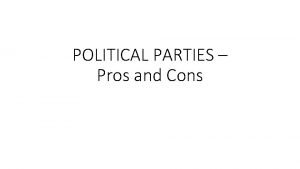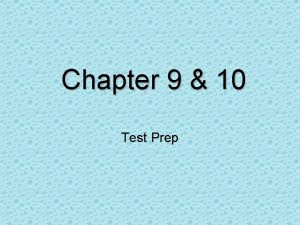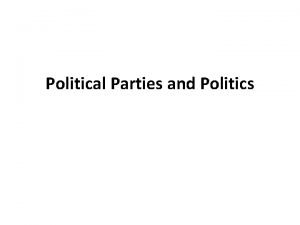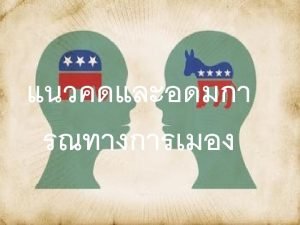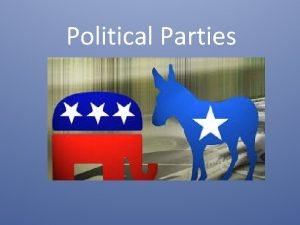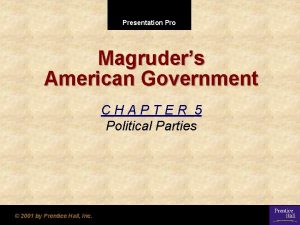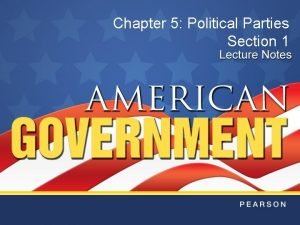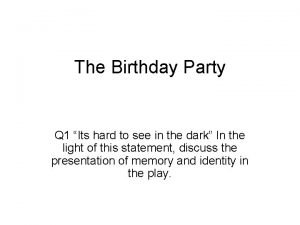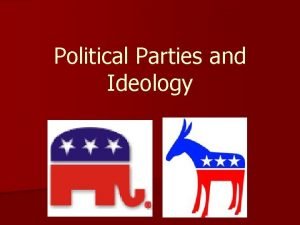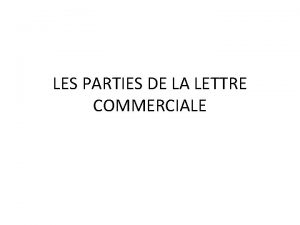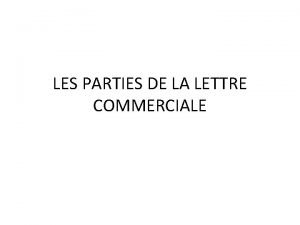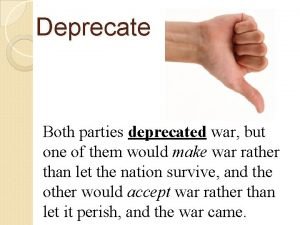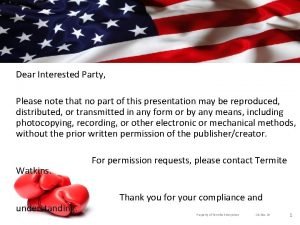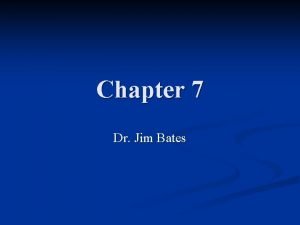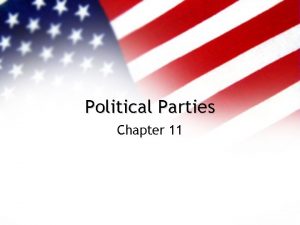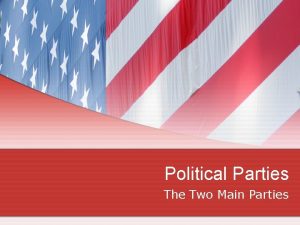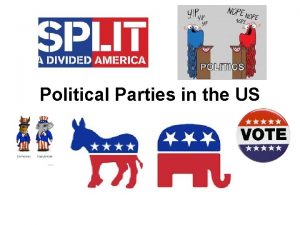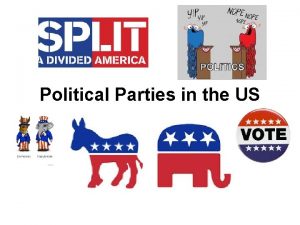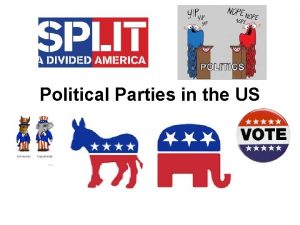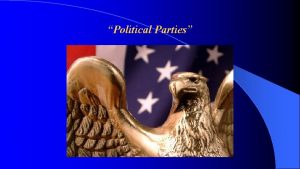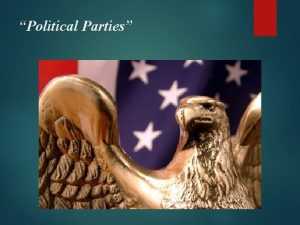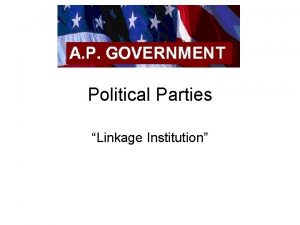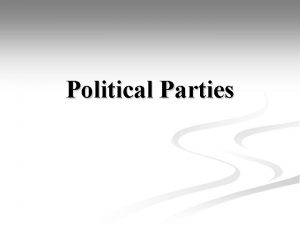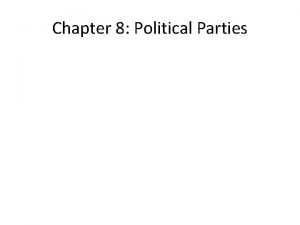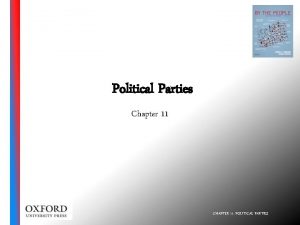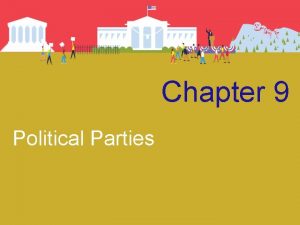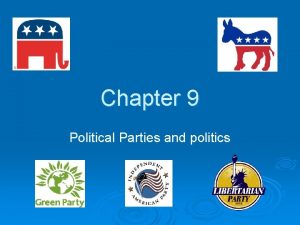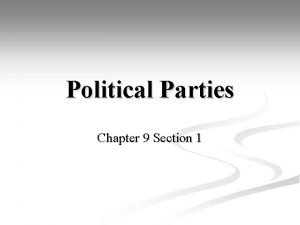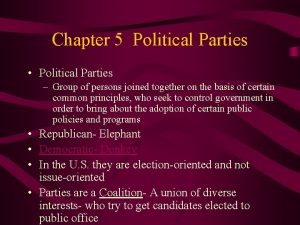Chapter 8 Political Parties Political Parties and Their
























- Slides: 24

Chapter 8: Political Parties

Political Parties and Their Functions • What is a Political Party? – Political party: an organization that sponsors candidates for political office under the organization’s name – Nomination: designation of as an official candidate of a political party Copyright © Houghton Mifflin Company. All rights reserved. 8|2

Political Parties and Their Functions • What is a Political Party? – Party Functions • Nominating candidates • Structuring voting choice • Proposing alternative government programs • Coordinating the action of government officials Copyright © Houghton Mifflin Company. All rights reserved. 8|3

A History of U. S. Party Politics • The Preparty Period – Parties were not mentioned in the Constitution – Parties did not exist in any recognizable form: factions were a source of concern – Factional politics grew during Washington’s presidency Copyright © Houghton Mifflin Company. All rights reserved. 8|4

A History of U. S. Party Politics • The First Party System: Federalists and Democratic Republicans – Election of 1796: the Federalists, led by Hamilton, faced the Democratic Republicans, led by Jefferson – Election of 1800: parties nominate candidates more systematically – Election of 1820: Federalists no longer exist; Monroe runs unopposed for presidency – Election of 1824: • J. Q. Adams loses the popular vote but wins in the House to become president • Democratic Republicans split into two parties Copyright © Houghton Mifflin Company. All rights reserved. 8|5

A History of U. S. Party Politics • The Second Party System: Democrats and Whigs – Election of 1828: Democratic party is formed – Parties begin holding national conventions in the 1830 s – Whigs are formed in response to Andrew Jackson’s presidency in 1834; are defunct by 1856 Copyright © Houghton Mifflin Company. All rights reserved. 8|6

A History of U. S. Party Politics • The Current Party System: Democrats and Republicans – The Republican party was formed in 1854 in opposition to slavery – Critical elections have marked the present party system • Critical Elections: elections that produced a sharp change in patterns of party loyalty among voters and lasting electoral realignment voting patterns that occurs after a critical election • The election of 1860 was the first critical election Copyright © Houghton Mifflin Company. All rights reserved. 8|7

A History of U. S. Party Politics • Eras of Party Dominance Since the Civil War – Election of 1860 established the two-party system • Two-party system: a political system in which two major political parties compete for control of the government; candidates from a third party have little chance of winning office • Third party candidates may be more successful at state or local level – Voters in a given region may strongly favor one party over another Copyright © Houghton Mifflin Company. All rights reserved. 8|8

A History of U. S. Party Politics • Eras of Party Dominance Since the Civil War – The balance between the two major parties at the national level • A Rough Balance: 1860 -1894 • A Republican Majority: 1896 – 1930 • A Democratic Majority: 1932 -1964 – A Rough Balance: 1968 -Present – Electoral dealignment: a lessening of the importance of party loyalties in voting decisions Copyright © Houghton Mifflin Company. All rights reserved. 8|9

Two-Party System in American History Copyright © Houghton Mifflin Company. All rights reserved. 8 | 10

The American Two-Party System • Minor Parties in America – Types of minor parties • Bolter parties • Farmer-labor parties • Parties of ideological protest • Single-issue parties – Minor parties’ most important function: safety valve Copyright © Houghton Mifflin Company. All rights reserved. 8 | 11

The American Two-Party System • Why a Two-Party System? – The Electoral System – The Importance of the Presidency – Political socialization allows the parties to persist Copyright © Houghton Mifflin Company. All rights reserved. 8 | 12

Party Candidates for the U. S. House in 2004 Copyright © Houghton Mifflin Company. All rights reserved. 8 | 13

Candidates and Parties in the 2004 Presidential Election Copyright © Houghton Mifflin Company. All rights reserved. 8 | 14

The American Two-Party System • Federal Basis of the Party System – Party politics on the state and local levels often functions quite differently than on the national level – Candidates win state and local offices even when the presidential candidate is defeated Copyright © Houghton Mifflin Company. All rights reserved. 8 | 15

Distribution of Party Identification Copyright © Houghton Mifflin Company. All rights reserved. 8 | 16

Party Identification by Social Groups Copyright © Houghton Mifflin Company. All rights reserved. 8 | 17

Party Ideology and Organization • Democrats and Republicans differ considerably in political ideology – Democrats spend to advance social welfare – Republicans spend on other priorities, including defense – There is a large ideological gap between activists in the two parties – Parties’ platforms are very different in both style and substance – Despite ideological differences, the parties are similar in that they are both capitalist parties that reject government ownership of the means of production Copyright © Houghton Mifflin Company. All rights reserved. 8 | 18

Party Ideology and Organization • National Party Organization – At the national level, each major party has four main organizational components • A national convention • A national committee • Congressional party conferences • Congressional campaign organizations Copyright © Houghton Mifflin Company. All rights reserved. 8 | 19

Party Ideology and Organization • National Party Organization – The role of the national committees changed during the 1970 s • Democrats focused on being more inclusive in choosing convention delegates • Republicans focused on strengthening fundraising, research and service roles Copyright © Houghton Mifflin Company. All rights reserved. 8 | 20

Party Ideology and Organization • State and Local Party Organizations – Party machines were crippled by federal expansion of social services – Individual state and local organizations vary widely in strength Copyright © Houghton Mifflin Company. All rights reserved. 8 | 21

Party Ideology and Organization • American political parties are among the most decentralized in the world – Parties as organizations are becoming stronger – Still a question as to how well they link voters to government Copyright © Houghton Mifflin Company. All rights reserved. 8 | 22

Ideologies of Party Voters and Party Delegates in 2004 Copyright © Houghton Mifflin Company. All rights reserved. 8 | 23

The Model of Responsible Party Government • Four principles of responsible party government: – Parties should present clear and coherent programs to voters – Voters should choose candidates on the basis of party programs – The winning party should carry out its program once in office – Voters should hold the governing party responsible at the next election for executing its program • Parties seem to be fulfilling the 1 st and 3 rd principles Copyright © Houghton Mifflin Company. All rights reserved. 8 | 24
 Political parties pros and cons
Political parties pros and cons Brainpop political parties
Brainpop political parties What was one way progressives differed from populists
What was one way progressives differed from populists Political parties
Political parties Political parties
Political parties A political party is an association of
A political party is an association of Soup and ideology
Soup and ideology Political parties
Political parties Chapter 5 section 1 parties and what they do
Chapter 5 section 1 parties and what they do Chapter 5 section 1 parties and what they do
Chapter 5 section 1 parties and what they do Economic protest parties definition
Economic protest parties definition Accounting information system chapter 1
Accounting information system chapter 1 Romeo and juliet prolouge
Romeo and juliet prolouge Iso 14001 swot analysis example
Iso 14001 swot analysis example Sarah and pam often go to parties
Sarah and pam often go to parties Kids birthday program
Kids birthday program Self-announcement definition
Self-announcement definition Food feast
Food feast Les différentes parties de la lettre commerciale
Les différentes parties de la lettre commerciale Les différentes parties de la lettre commerciale
Les différentes parties de la lettre commerciale Les races de dauphins
Les races de dauphins Both parties deprecated war meaning
Both parties deprecated war meaning Dear interested parties
Dear interested parties Microscope et ses parties
Microscope et ses parties Why does gatsby stop giving parties
Why does gatsby stop giving parties
